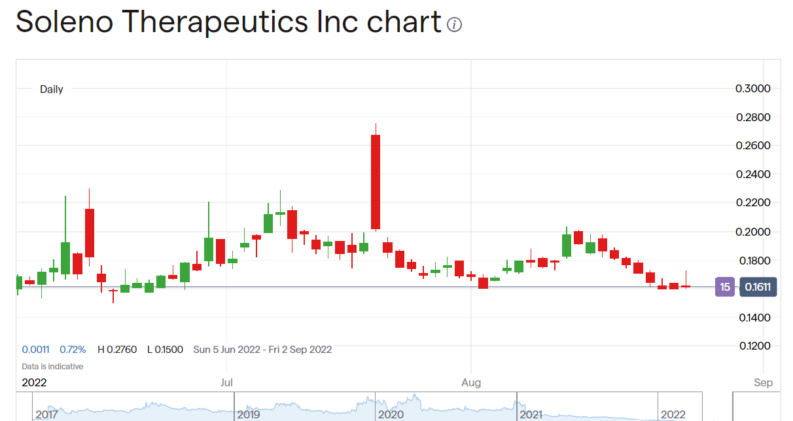Key points:
- We can describe Soleno Thera's stock price as being up 1,121% this morning
- We can also describe it as being down 25%
- But which is the relevant and correct description to use?
Soleno Therapeutics (NASAQ SLNO) stock is listed as being up 1,121% premarket. But it's equally correct to say that SLNO is in fact down 25% premarket. We are in one of those Schroedinger's stock price exercises where we've a choice of two equally accurate – but wildly divergent – stock price changes. The answer is, of course, that one price change here is a purely nominal one, the other is a real price change. And, yes, it's the decline which is the real one, the decline that actually hits pocketbooks. And isn't that nice?
As to what Soleno Therapeutics does it's a clinical stage biopharmaceutical company – one of those known capital guzzlers. Soleno concentrates upon novel therapeutics for rare diseases – this takes advantage of orphan status and so on in the FDA approval system. The lead candidate is a pill for Prader-Willi Syndrome which is in Phase III trials. There was, back in July, for example, a 49% surge in the Soleno stock price when the regulatory pathway for that Prader-Willi treatment opened up. But therapy, drug, development take a long, long, time. Which is why such companies tend to eat capital – for of course there's no income until a drug does finally gain FDA approval.
The result is that SLNO stock is down 82% over the past year and 94% over 5 years. This then poses a problem for the company – NASDAQ. For if your stock price goes below $1 then stays there you'll lose your NASDAQ quotation. This means relegation to the OTC markets and that's a much more difficult place to raise capital from. That could mean not being able to finish off the drug development if the fiscal runway is exhausted. Thus something has to be done to get that Soleno stock price back up above one dollar.

Also Read: Five Best Pharmaceutical Stocks to Watch in 2022
That something is to have a reverse stock split. As per the NASDAQ announcement this is a 15 for one one. What used to be 15 shares becomes just the one – and that's it really. The market valuation of the company as a whole should not change, the value of any individual stockholding should not, it's a purely nominal price change – the number of pieces of stock in issue changes.
Now, the thing is, this should be a purely nominal price change. Therefore the price should rise by 1,500%. 15 shares become one, one piece of stock in SLNO should now be worth what 15 pieces were. Last night's closing was $0.16, or 16 cents, that times 15 is $2.40, the opening price this morning should be $2.40. But it isn't, it's $1.96. So, that's up 1,121% in nominal terms, Or, more accurately, down 25% (or 20%, depending on what you want to use as the denominator). And that's the real number – the number by which any position in Soleno has fallen in value. That's also the fall in the market capitalisation of Soleno as well – obviously.
This is one of the things about stock splits, whether reverse or not. They should – should because this is why they are undertaken – increase the value of the company. But sometimes they don't, as here.




